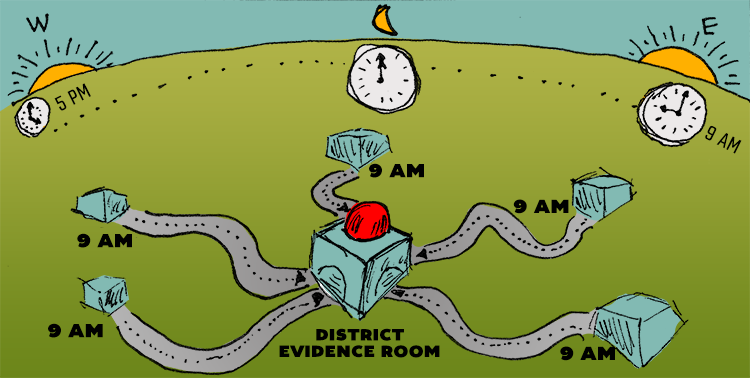CHALLENGER INSIGHTS Vol. 9:
Precinct/District Evidence Rooms

Recently, I was in Cincinnati, Ohio with Gordon Kwiecinski of Patterson Pope, meeting with the Cincinnati Police Department about an evidence storage project. Cincinnati PD is what I’d call an “old school” department—there are over a 1,000 sworn officers, and those officers cover five districts. Cincinnati PD has a central evidence facility, but evidence is collected at each district office.
The interesting part of this set-up is the time period between the end of “normal business hours” and the next morning. Evidence and property that’s collected each day is held in each one of these district offices, and in the morning, an officer will bring all evidence from their district to the main office. The front of the evidence room is set up similar to a bank with transaction windows and a lobby. An officer from each district waits in the lobby for a turn to have the evidence received, logged, and a transaction receipt for the district.
Needless to say, I had many questions—and came away from the conversation wondering how sales reps might be able to better position ourselves when it comes to these precinct or district offices.
The first question that came to mind was, “How much patrol time are you losing?” With traffic, the districts located the farthest away must be burning at least two hours of their shift simply bringing evidence in and waiting for it to be processed. The second had to do with the central evidence facility—their evidence room consisted of a large section of shelves divided by month. After 12 months, they review the evidence and purge or store depending on the retention required by law. Because of this system, they held on to property and evidence a lot longer than necessary in many situations.
Don’t be afraid to offer a bold idea.
Once I learned how evidence was collected, transported, and processed, I couldn’t help but ask our contact, “Why not store evidence by size, and not date?” For these types of departments, it can be hard to break from the old way of thinking. When I asked about storing evidence by size, not date—I wasn’t trying to stir the pot—I was sincerely wanting to create a solution where those extra trips to the main office could be eliminated, extra space could be created through optimizing for size, and evidence room managers wouldn’t have to move evidence multiple times.
Offer to connect them with a similar Lighthouse account.
Considering the options for quality Spacesaver installations at a comparable size department, Gordon identified Louisville Police Department as a good Lighthouse reference. Louisville Police Department had installed several Spacesaver high density mobile systems, and they have a well-run evidence department. We put key members of the department in contact with Louisville for advice on how to reorganize their evidence in a way that would save time for the evidence staff and save space for the evidence room.
Have you worked with a police department with an interesting evidence storage situation? How did you help them see things in a new way—or create efficiencies and organization in spite of their storage processes? Let McKenna know at mdustman@spacesaver.com.